Application of BEMD in Extracting Gravity Anomaly Components Showing Deep Ore-Forming Dynamic Background of Jiaodong Gold Cluster Region
Abstract
1. Introduction
2. Principle and Method of BEMD
- (1)
- Initialization: r0(m, n) = Ori(m, n), and i = 1 is the BIMF index;
- (2)
- Extraction of the ith BIMF component:
- (i)
- Initialize and make h0(m, n) = ri−1(m, n), j = 1;
- (ii)
- Detect all the points of local upper (upperj−1) and local lower (lowerj−1) of hj−1(m, n), respectively;
- (iii)
- Compute the upper (lower) envelope of the local maximum and local minimum point, respectively;
- (iv)
- Calculate the envelope mean: meanj−1(m, n) = (upperj−1(m, n) + lowerj−1(m, n))/2;
- (v)
- hj (m, n) = hj−1(m, n) − mj−1(x, y), j = j + 1;
- (vi)
- hj(m, n) = BIMFi(m, n) if hj(m, n) matches the stopping criterion, then the ith BIMF is got, or
- (vii)
- Repeat steps (ii)–(vi);
- (3)
- ri (m, n) = ri−1(m, n) − BIMFi(m, n);
- (4)
- Go to step (2), when the number of extrema in ri(m, n) is more than 2, i = i + 1 or the decomposition is ended.
3. Extraction of Gravity Anomaly Components
3.1. Gravity Data Set and Gravity Field
3.2. Application of Power Spectrum Analysis in Approximately Estimating the Depth of BIMFi
- (1)
- Transform the gravity anomaly component data from the spatial domain to the frequency domain using a two-dimensional Fourier transform;
- (2)
- Square the two-dimensional Fourier transformation result to obtain the power spectrum value;
- (3)
- Convert the power spectrum’s coordinates from Cartesian to polar, then compute the arithmetic mean of power spectrum values covered within each radial frequency bin;
- (4)
- Draw the radial average logarithmic power spectrum curve through the radial frequency value and the logarithm of the corresponding radial average power spectrum value;
- (5)
- The least square method is used to fit the appropriate frequency band, and the average top depth of the field source is calculated according to the slope of the fitting straight line (Equation (8)):
4. Results and Discussion
5. Conclusions
- (1)
- The bi-intrinsic mode functions (BIMFs), extracted by BEMD from the gravity data, can be categorized as three filters: high-pass, band-pass, and low-pass. Some BIMFs represent a specific range of frequency structures of the gravity data.
- (2)
- The bi-intrinsic mode function, obtained by the high-pass filter, represents a gravity anomaly component with high frequency, which characterizes superficial geological bodies with different densities, such as granitoids, basalt, and volcanic sediments, in this study area.
- (3)
- The bi-intrinsic mode function, extracted by the band-pass filter, is a gravity anomaly component with medium frequency, which implies that the deep part of geological architecture reflects basement uplift and/or depression such as the Laixi uplift.
- (4)
- The bi-intrinsic mode function, extracted by the low-pass filter, is a gravity anomaly component with low frequency, which implies that the deepest part of the geological architecture reflects mantle uplift (Unit I in Figure 10e) and/or depression (Unit II in Figure 10e). The concentration of the majority of giant gold deposits in the JGCR within Unit II (Figure 10e) is inferred to be associated with the mantle ore-forming fluids concentrated in the mantle depression.
Author Contributions
Funding
Data Availability Statement
Acknowledgments
Conflicts of Interest
References
- Zhou, X.; Yang, J.; Zhang, L. Metallogenesis of Superlarge Gold Deposits in Jiaodong Region and Deep Processes of Subcontinental Lithosphere Beneath North China Craton in Mesozoic. Sci. China Ser. D Earth Sci. 2003, 46, 14–25. [Google Scholar] [CrossRef]
- Deng, J.; Wang, Q.F.; Zhang, L.; Xue, S.C.; Liu, X.F.; Yang, L.; Liang, Y.Y. Metallogenetic Model of Jiaodong-Type Gold Deposits, Eastern China. Sci. China Earth Sci. 2023, 66, 2287–2310. [Google Scholar] [CrossRef]
- Yang, L.Q.; Wang, G.J.; Zhang, Z.J.; Deng, J.; Zhao, A.H.; Wang, J.P. Lithospheric Structure and Deep-Seated Mineralization in Jiaodong Gold Deposit Concentration Region, Shandong, China. Earth Sci. 2000, 25, 421–427. [Google Scholar]
- Zhang, Q.; Song, M.; Ding, Z.; Guo, M.; Zhou, M.; Dai, C.; Huo, G.; Zhang, P. Exhumation History and Preservation of the Jiaojia Giant Gold Deposit, Jiaodong Gold Cluster Region. Sci. China Earth Sci. 2022, 65, 1161–1177. [Google Scholar] [CrossRef]
- Deng, J.; Wang, Q.; Liu, X.; Zhang, L.; Yang, L.; Yang, L.; Qiu, K.; Guo, L.; Liang, Y.; Ma, Y. The Formation of the Jiaodong Gold Province. Acta Geol. Sin. 2022, 96, 1801–1820. [Google Scholar] [CrossRef]
- Xie, Z.; Li, Q.Z.; Gao, T.S. Comment on “Petrogenesis of Post-Orogenic Syenites in the Sulu Orogenic Belt, East China: Geochronological, Geochemical and Nd–Sr Isotopic Evidence” by Yang et al. Chem. Geol. 2006, 235, 191–194. [Google Scholar] [CrossRef]
- Goldfarb, R.J.; Qiu, K.F.; Deng, J.; Chen, Y.J.; Yang, L.Q. Orogenic gold deposits of China. Soc. Econ. Geol. 2019, 22, 263–324. [Google Scholar] [CrossRef]
- Goldfarb, R.J.; Santosh, M. The Dilemma of the Jiaodong Gold Deposits: Are They Unique? Geosci. Front. 2014, 5, 139–153. [Google Scholar] [CrossRef]
- Goldfarb, R.J.; Hart, C.; Davis, G. East Asian Gold: Deciphering the Anomaly of Phanerozoic Gold in Precambrian Cratons. Econ. Geol. 2007, 102, 341–345. [Google Scholar] [CrossRef]
- Song, M.; Song, Y.; Li, J.; Li, S. Metallogenic Series of Gold and Nonferrous Metal Deposits Related to Cretaceous Granites in Eastern Shandong Peninsula, China. Acta Geol. Sin. 2015, 39, 828–843. [Google Scholar] [CrossRef]
- Liu, J.L.; Ji, L.; Ni, J.L.; Chen, X.Y. Dynamics of the Early Cretaceous Lithospheric Thinning and Destruction of the North China Craton as the Consequence of Paleo-Pacific Type Active Continental Margin. Acta Geol. Sin. 2022, 96, 3360–3380. [Google Scholar] [CrossRef]
- Yang, C.; Santosh, M. Ancient Deep Roots for Mesozoic World-Class Gold Deposits in the North China Craton: An Integrated Genetic Perspective. Geosci. Front. 2020, 11, 203–214. [Google Scholar] [CrossRef]
- Qiu, K.-F.; Yu, H.-C.; Deng, J.; McIntire, D.; Gou, Z.-Y.; Geng, J.-Z.; Chang, Z.-S.; Zhu, R.; Li, K.-N. The Giant Zaozigou Au-Sb Deposit in West Qinling, China: Magmatic- or Metamorphic-Hydrothermal Origin? Mineral. Depos. 2020, 55, 345–362. [Google Scholar] [CrossRef]
- Zheng, A.; Chen, C.; Chen, Y.; Zhao, B.; Zhao, P. Application of Anomaly Components of Multi-Element Combination Extracted from Stream Sediments Data by BEMD in Mapping Ore Prospectivity within the JGCR, Eastern China. Appl. Geochem. 2024, 169, 106034. [Google Scholar] [CrossRef]
- Chen, Y.; Zhang, L.; Zhao, B. Identification of the Anomaly Component Using BEMD Combined with PCA from Element Concentrations in the Tengchong Tin Belt, SW China. Geosci. Front. 2019, 10, 1561–1576. [Google Scholar] [CrossRef]
- Huang, N.E. Beyond the Fourier Transform: Coping with Nonlinear, Nonstationary Time Series; Goddard Institute for Data Analysis, NASA Goddard Space Flight Center: Greenbelt, MD, USA, 26 May 2006; Available online: https://lcp.csail.mit.edu/events/hrv-2006/huang.pdf (accessed on 30 October 2025).
- Nunes, J.; Bouaoune, Y.; Delechelle, E.; Niang, O.; Bunel, P. Image Analysis by Bidimensional Empirical Mode Decomposition. Image Vis. Comput. 2003, 21, 1019–1026. [Google Scholar] [CrossRef]
- Nunes, J.C.; Guyot, S.; Deléchelle, E. Texture Analysis Based on Local Analysis of the Bidimensional Empirical Mode Decomposition. Mach. Vis. Appl. 2005, 16, 177–188. [Google Scholar] [CrossRef]
- Freire, M.L.S.; Ulrych, J.T. Application of Singular Value Decomposition to Vertical Seismic Profiling. Geophysics 2012, 53, 778–785. [Google Scholar] [CrossRef]
- Chen, Y.; Zhang, L.; Zhao, B. Application of Bi-Dimensional Empirical Mode Decomposition (BEMD) Modeling for Extracting Gravity Anomaly Indicating the Ore-Controlling Geological Architectures and Granites in the Gejiu Tin-Copper Polymetallic Ore Field, Southwestern China. Ore Geol. Rev. 2016, 88, 832–840. [Google Scholar] [CrossRef]
- Huang, J.N.; Zhao, B.B.; Chen, Y.Q.; Zhao, P. Bidimensional Empirical Mode Decomposition (BEMD) for Extraction of Gravity Anomalies Associated with Gold Mineralization in the Tongshi Gold Field, Western Shandong Uplifted Block, Eastern China. Comput. Geosci. 2010, 36, 987–995. [Google Scholar] [CrossRef]
- Liu, J.L.; Ni, J.L.; Chen, X.Y.; Craddock, J.P.; Zheng, Y.; Ji, L.; Hou, C. Early Cretaceous Tectonics across the North Pacific: New Insights from Multiphase Tectonic Extension in Eastern Eurasia. Earth-Sci. Rev. 2021, 217, 103552. [Google Scholar] [CrossRef]
- Kane, M.F.; Godson, R.H. Features of a Pair of Long-Wavelength (>250 km) and Short-Wavelength (<250 km) Bouguer Gravity Maps of the United States. In The Utility of Regional Gravity and Magnetic Anomaly Maps; Society of Exploration Geophysicists: Tulsa, OK, USA, 1985; pp. 46–61. [Google Scholar] [CrossRef]
- Zeng, G.X.; Lü, C.; Xu, J.F. Geology of Iron Ore Deposits in Shandong; Shandong Science and Technology Press: Jinan, China, 1998. [Google Scholar]
- Goldfarb, R.J.; Mao, J.-W.; Qiu, K.-F.; Goryachev, N. The Great Yanshanian Metallogenic Event of Eastern Asia: Consequences from One Hundred Million Years of Plate Margin Geodynamics. Gondwana Res. 2021, 100, 223–250. [Google Scholar] [CrossRef]
- Chen, G.; Cheng, Q.; Zuo, R.; Liu, T.; Xi, Y. Identifying Gravity Anomalies Caused by Granitic Intrusions in Nanling Mineral District, China: A Multifractal Perspective. Geophys. Prospect. 2015, 63, 256–270. [Google Scholar] [CrossRef]
- Chen, Y.; Zhang, L.; Zhao, B. Application of Singular Value Decomposition (SVD) in Extraction of Gravity Components Indicating the Deeply and Shallowly Buried Granitic Complex Associated with Tin Polymetallic Mineralization in the Gejiu Tin Ore Field, Southwestern China. J. Appl. Geophys. 2015, 123, 63–70. [Google Scholar] [CrossRef]
- Zhao, D.; Maruyama, S.; Omori, S. Mantle Dynamics of Western Pacific and East Asia: Insight from Seismic Tomography and Mineral Physics. Gondwana Res. 2006, 11, 120–131. [Google Scholar] [CrossRef]
- Zhu, G.; Jiang, D.; Zhang, B.; Chen, Y. Destruction of the Eastern North China Craton in a Backarc Setting: Evidence from Crustal Deformation Kinematics. Gondwana Res. 2012, 22, 86–103. [Google Scholar] [CrossRef]
- Guo, P.; Santosh, M.; Li, S. Geodynamics of Gold Metallogeny in the Shandong Province, NE China: An Integrated Geological, Geophysical and Geochemical Perspective. Gondwana Res. 2013, 24, 1172–1202. [Google Scholar] [CrossRef]
- Song, M.C.; Song, Y.X.; Ding, Z.J.; Li, S.Y. Jiaodong Gold Deposits: Essential Characteristics and Major Controversy. Gold Sci. Technol. 2018, 26, 406–422. [Google Scholar] [CrossRef]
- Spector, A.; Grant, F.S. Statistical Models for Interpreting Aeromagnetic Data. Geophysics 1970, 35, 293–302. [Google Scholar] [CrossRef]
- Maus, S.; Dimri, V. Potential Field Power Spectrum Inversion for Scaling Geology. J. Geophys. Res. 1995, 100, 12605–12616. [Google Scholar] [CrossRef]
- Zhang, S.X.; Chen, C.; Wang, L.S.; Wang, Q.G.; Wang, H.R.; Sun, S.D. The Bidimensional Empirical Mode Decomposition and Its Applications to Denoising and Separation of Potential Field. Prog. Geophys. 2015, 30, 2855–2862. [Google Scholar] [CrossRef]
- Zhu, Z.Y.; Liu, G.F. Analysis of Potential Field Data and Its Application Based on Bidimensional Empirical Mode Decomposition. Prog. Geophys. 2016, 31, 882–892. [Google Scholar] [CrossRef]
- Tao, G.; Wang, G.; Zhang, Z. Extraction of Mineralization-Related Anomalies from Gravity and Magnetic Potential Fields for Mineral Exploration Targeting: Tongling Cu(–Au) District, China. Nat. Resour. Res. 2019, 28, 461–486. [Google Scholar] [CrossRef]
- Zhang, S.X.; Chen, Z.H.; Wang, T.Q.; Liu, J.Z.; Zhang, P.; Zhu, C.D. The Extraction of Abnormal Feature of Mobile Gravity in the Sichuan-Yunnan Region Using BEMD Method. Geod. Geodyn. 2018, 38, 407–413. [Google Scholar] [CrossRef]
- Zhang, S.X.; Chen, Z.H.; Wang, Q.H.; Liu, J.Z.; Zhang, P. The Anomaly Feature Extraction of Mobile Gravity in the Sichuan-Yunnan Region Using Wavelet Transform Method—The Case Study of the Ludian MS6.5 and Jinggu MS6.6 Earthquakes in 2014. Geod. Geodyn. 2020, 40, 87–93. [Google Scholar] [CrossRef]
- Sun, F.Y. Mesozoic-Cenozoic Regional Tectonic Evolution and Gold Mineralization in Jiaodong Area, Shandong Province. Changchun Univ. Earth Sci. 1994, 24, 378–385. [Google Scholar]
- Xu, Y.G.; Huang, X.L.; Ma, J.L.; Wang, Y.-B.; Iizuka, Y.; Xu, J.-F.; Wang, Q.; Wu, X.-Y. Crust-Mantle Interaction during the Tectono-Thermal Reactivation of the North China Craton: Constraints from SHRIMP Zircon U–Pb Chronology and Geochemistry of Mesozoic Plutons from Western Shandong. Contrib. Mineral. Petrol. 2004, 147, 750–767. [Google Scholar] [CrossRef]
- Xu, Y. Thermo-Tectonic Destruction of the Archaean Lithospheric Keel Beneath the Sino-Korean Craton in China: Evidence, Timing and Mechanism. Phys. Chem. Earth Part A Solid Earth Geod. 2001, 26, 747–757. [Google Scholar] [CrossRef]
- Chen, Y.M.; Zeng, Q.D.; Sun, Z.F.; Wang, Z.K. Study on Geochemical Background Field of the Gold Deposits in Jiaodong, China. Gold Sci. Technol. 2019, 27, 791–801. [Google Scholar] [CrossRef]
- Dong, S.W.; Zhang, Y.Q.; Li, H.L.; Shi, W.; Xue, H.; Li, J.; Huang, S.; Wang, Y. The Yanshan Orogeny and Late Mesozoic Multi-Plate Convergence in East Asia—Commemorating 90th Years of the “Yanshan Orogeny”. Sci. China Earth Sci. 2018, 61, 1888–1909. [Google Scholar] [CrossRef]
- Goss, S.C.; Wilde, A.S.; Wu, F.; Yang, J. The Age, Isotopic Signature and Significance of the Youngest Mesozoic Granitoids in the Jiaodong Terrane, Shandong Province, North China Craton. Lithos 2010, 120, 309–326. [Google Scholar] [CrossRef]
- Yang, L.; Deng, J.; Guo, L.; Wang, Z.-L.; Li, X.-Z.; Li, J.-L. Origin and Evolution of Ore Fluid, and Gold-Deposition Processes at the Giant Taishang Gold Deposit, Jiaodong Peninsula, Eastern China. Ore Geol. Rev. 2016, 72, 585–602. [Google Scholar] [CrossRef]
- Deng, J.; Yang, L.Q.; Groves, D.I.; Zhang, L.; Qiu, K.-F.; Wang, Q.-F. An Integrated Mineral System Model for the Gold Deposits of the Giant Jiaodong Province, Eastern China. Earth-Sci. Rev. 2020, 208, 103274. [Google Scholar] [CrossRef]
- Zhang, Y.; Hu, F.; Fan, H.; Liu, X.; Feng, K.; Cai, Y.-C. Fluid Evolution and Gold Precipitation in the Muping Gold Deposit (Jiaodong, China): Insights from In-Situ Trace Elements and Sulfur Isotope of Sulfides. J. Geochem. Explor. 2020, 218, 106617. [Google Scholar] [CrossRef]
- Groves, D.I.; Santosh, M. Province-Scale Commonalities of Some World-Class Gold Deposits: Implications for Mineral Exploration. Geosci. Front. 2015, 6, 389–399. [Google Scholar] [CrossRef]
- Yang, Q.L.; Deng, J.; Zhang, L.; Zhao, A.-H.; Santosh, M.; Yu, X.-F.; Yang, W.; Li, D.-P.; Shan, W.; Xie, D.; et al. Mantle-Rooted Fluid Pathways and World-Class Gold Mineralization in the Giant Jiaodong Gold Province: Insights from Integrated Deep Seismic Reflection and Tectonics. Earth-Sci. Rev. 2024, 255, 104862. [Google Scholar] [CrossRef]
- Goldfarb, R.J.; Groves, D.I. Orogenic Gold: Common or Evolving Fluid and Metal Sources through Time. Lithos 2015, 233, 2–26. [Google Scholar] [CrossRef]
- Goldfarb, R.J.; Groves, D.I.; Gardoll, S.J. Orogenic Gold and Geologic Time: A Global Synthesis. Ore Geol. Rev. 2001, 18, 1–75. [Google Scholar] [CrossRef]
- Groves, D.I.; Santosh, M.; Goldfarb, R.J.; Zhang, L. Structural Geometry of Orogenic Gold Deposits: Implications for Exploration of World-Class and Giant Deposits. Geosci. Front. 2018, 9, 1163–1177. [Google Scholar] [CrossRef]
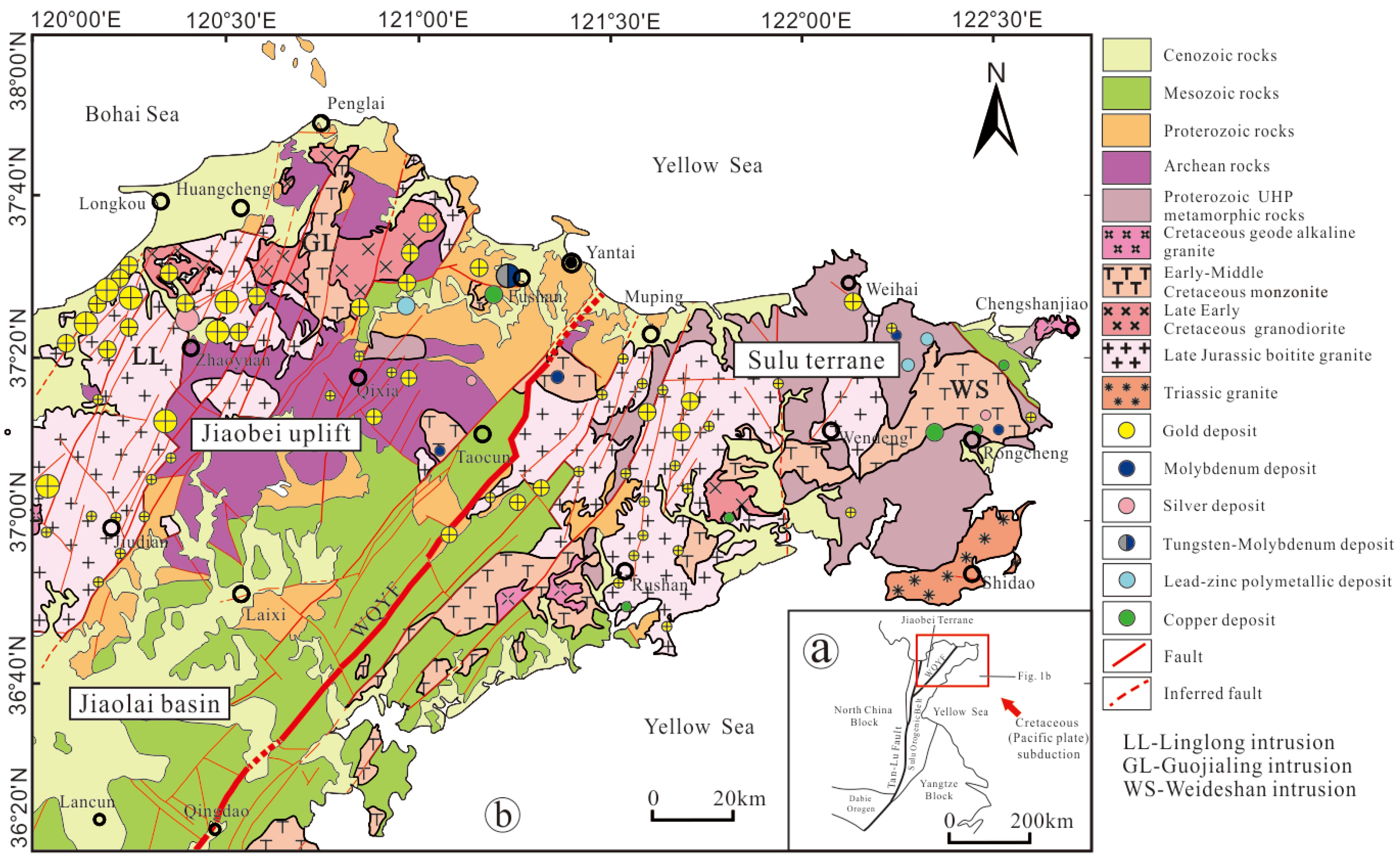
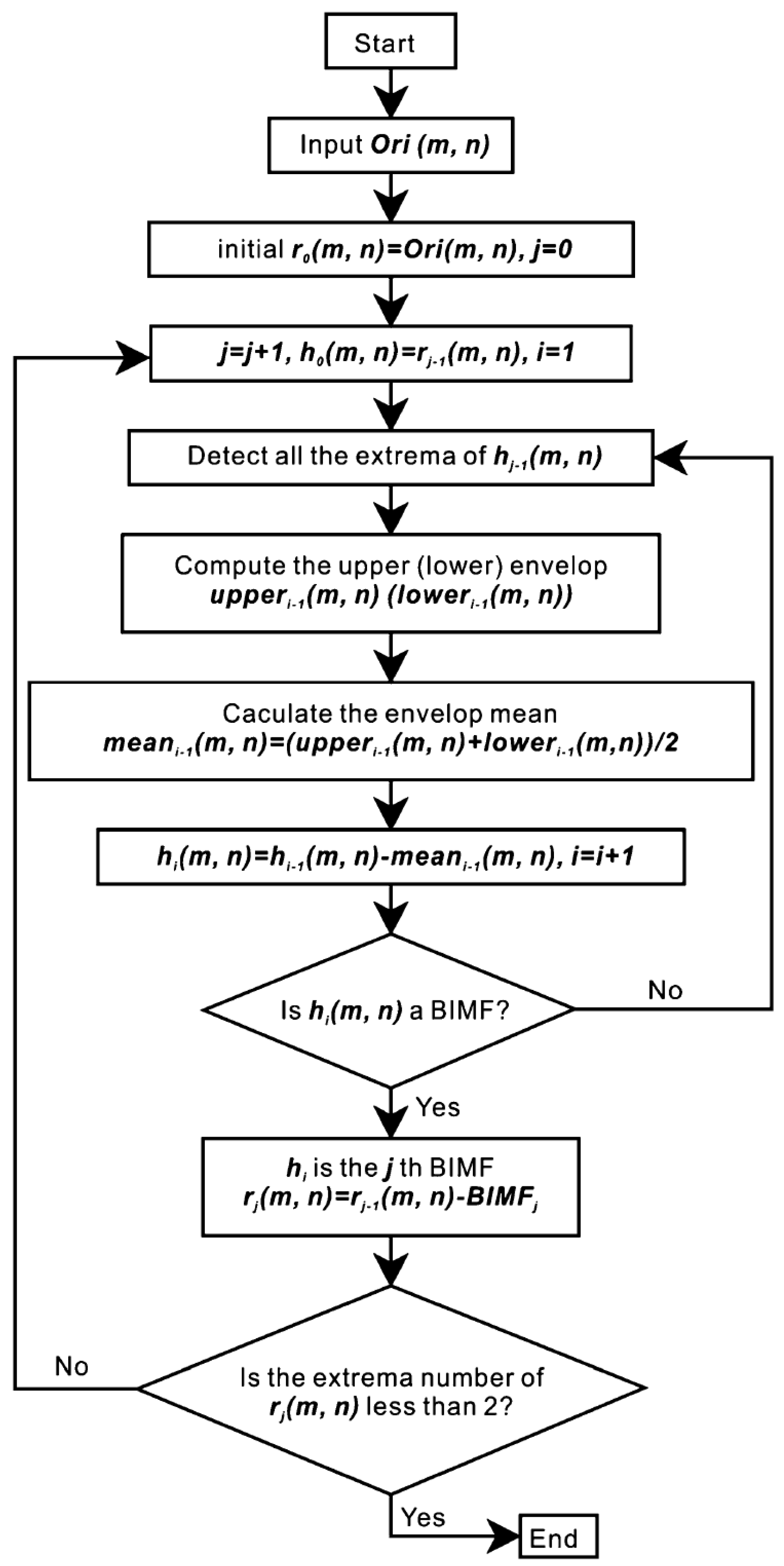
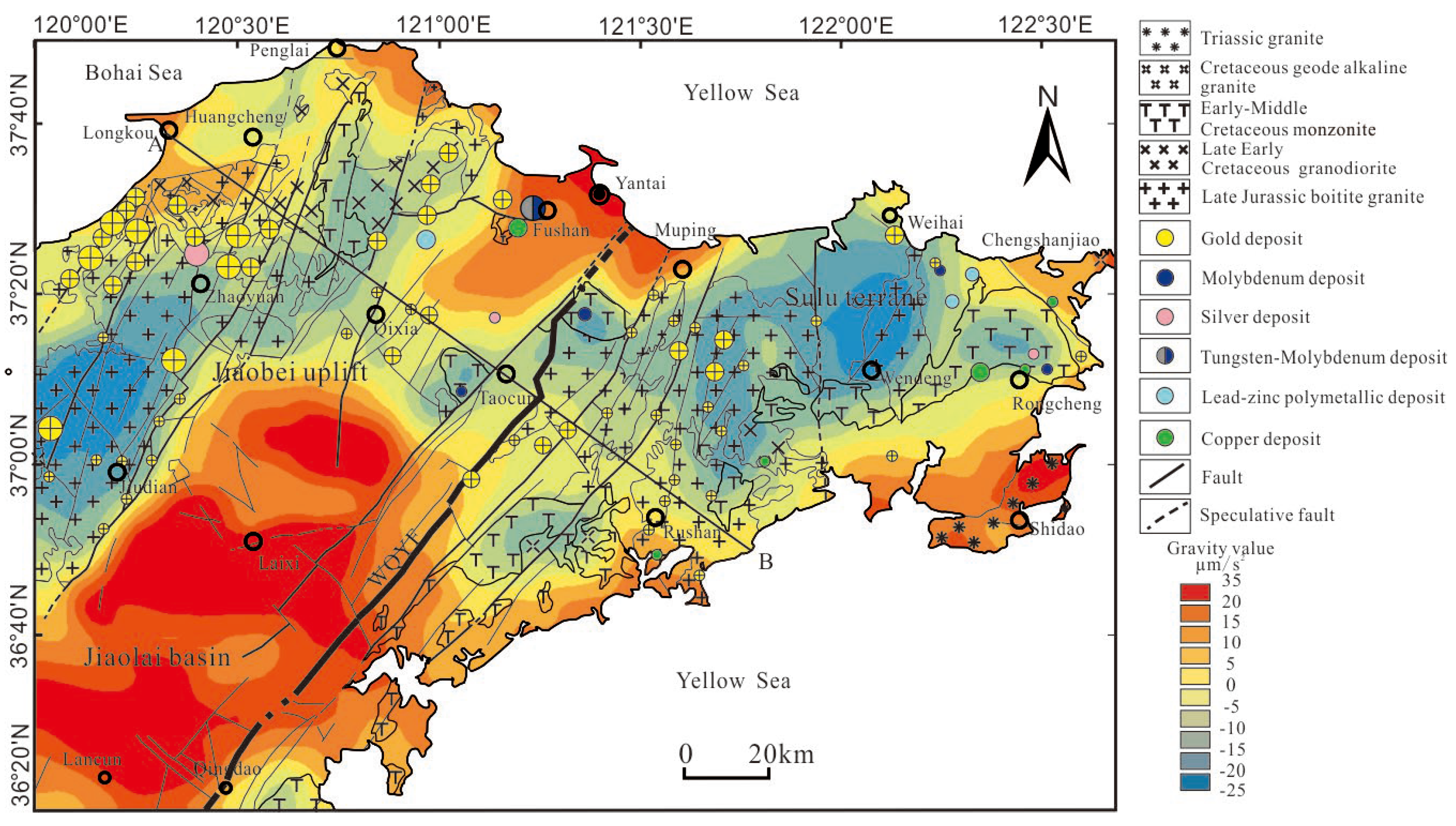


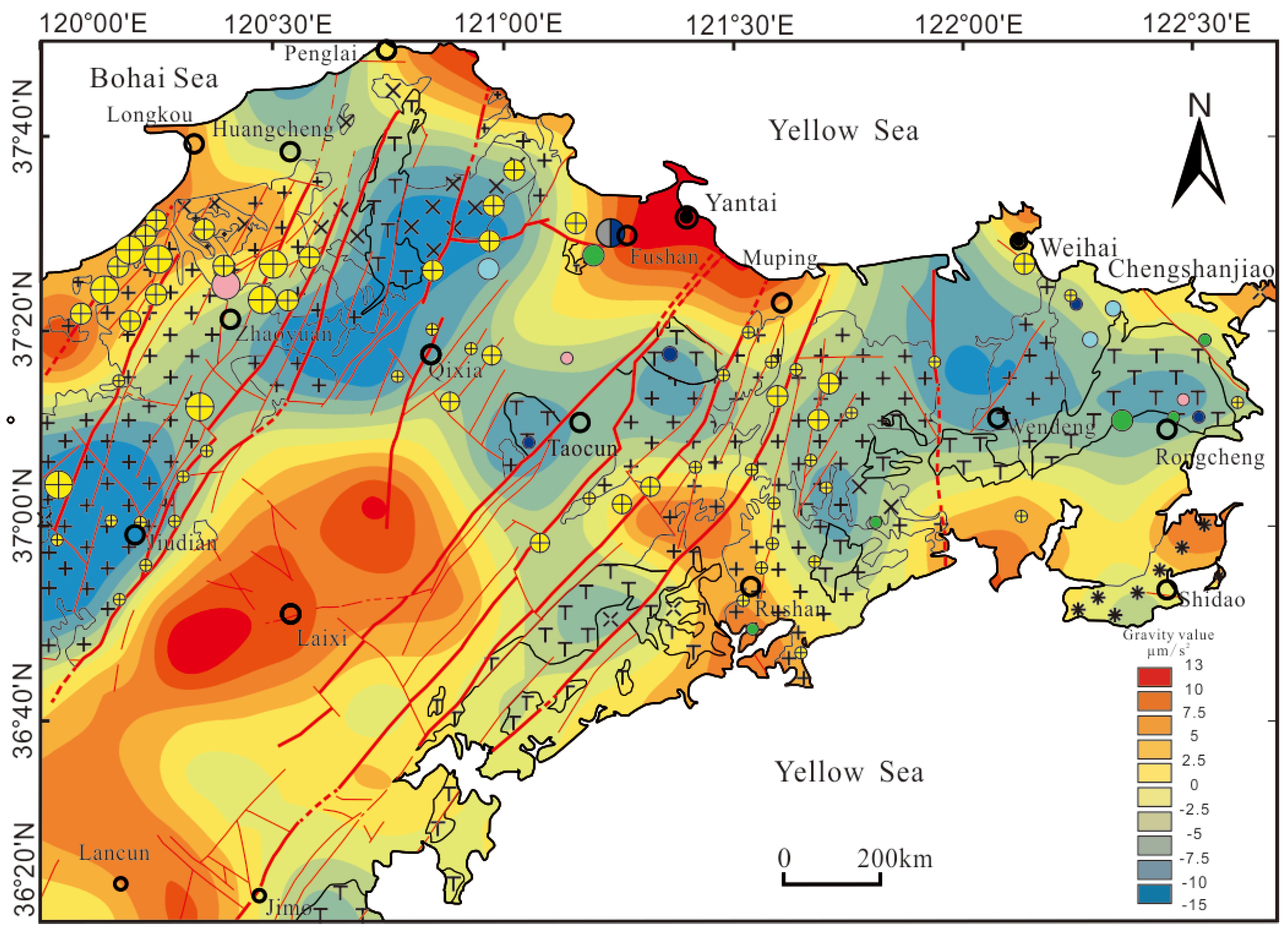
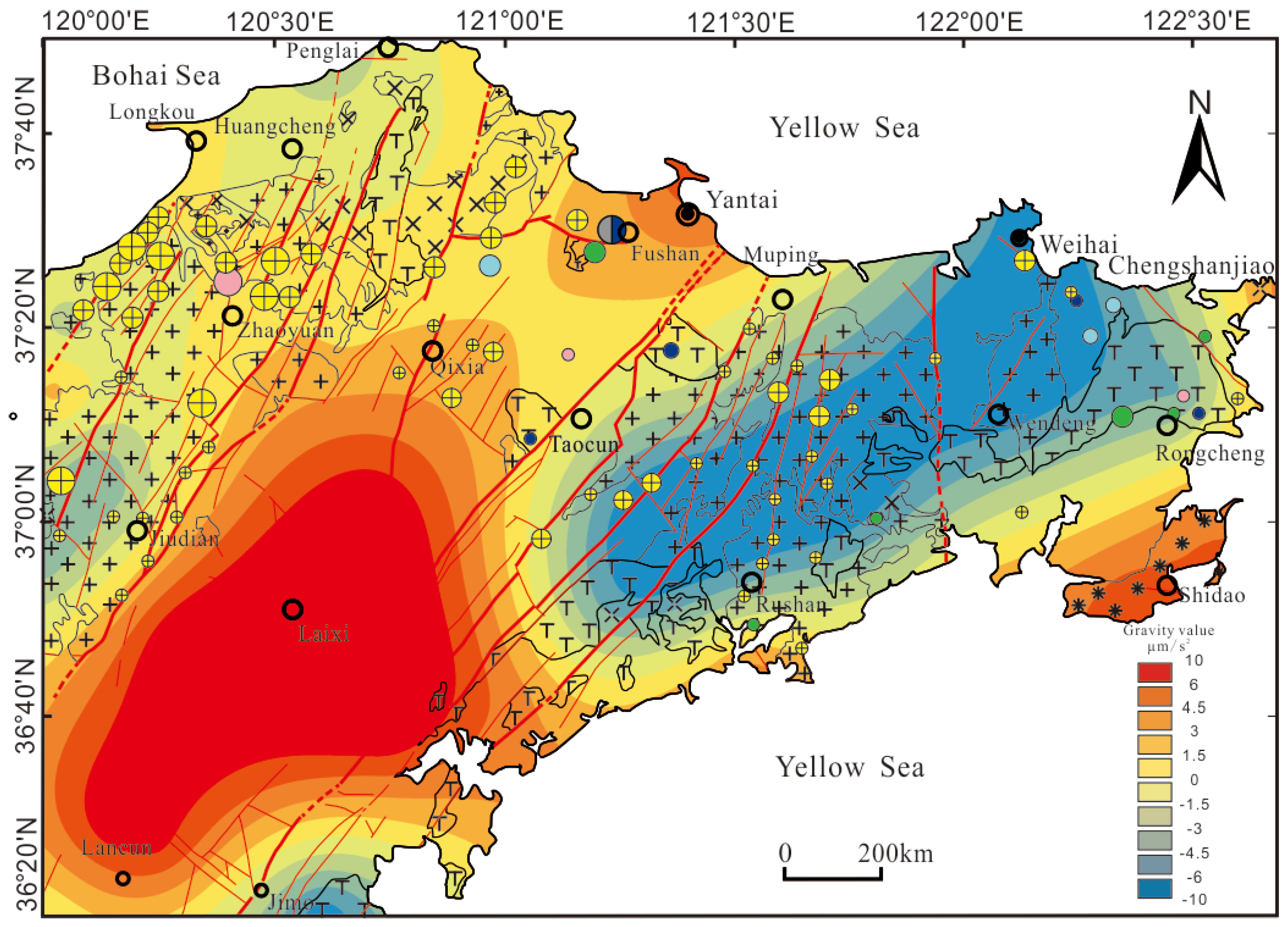

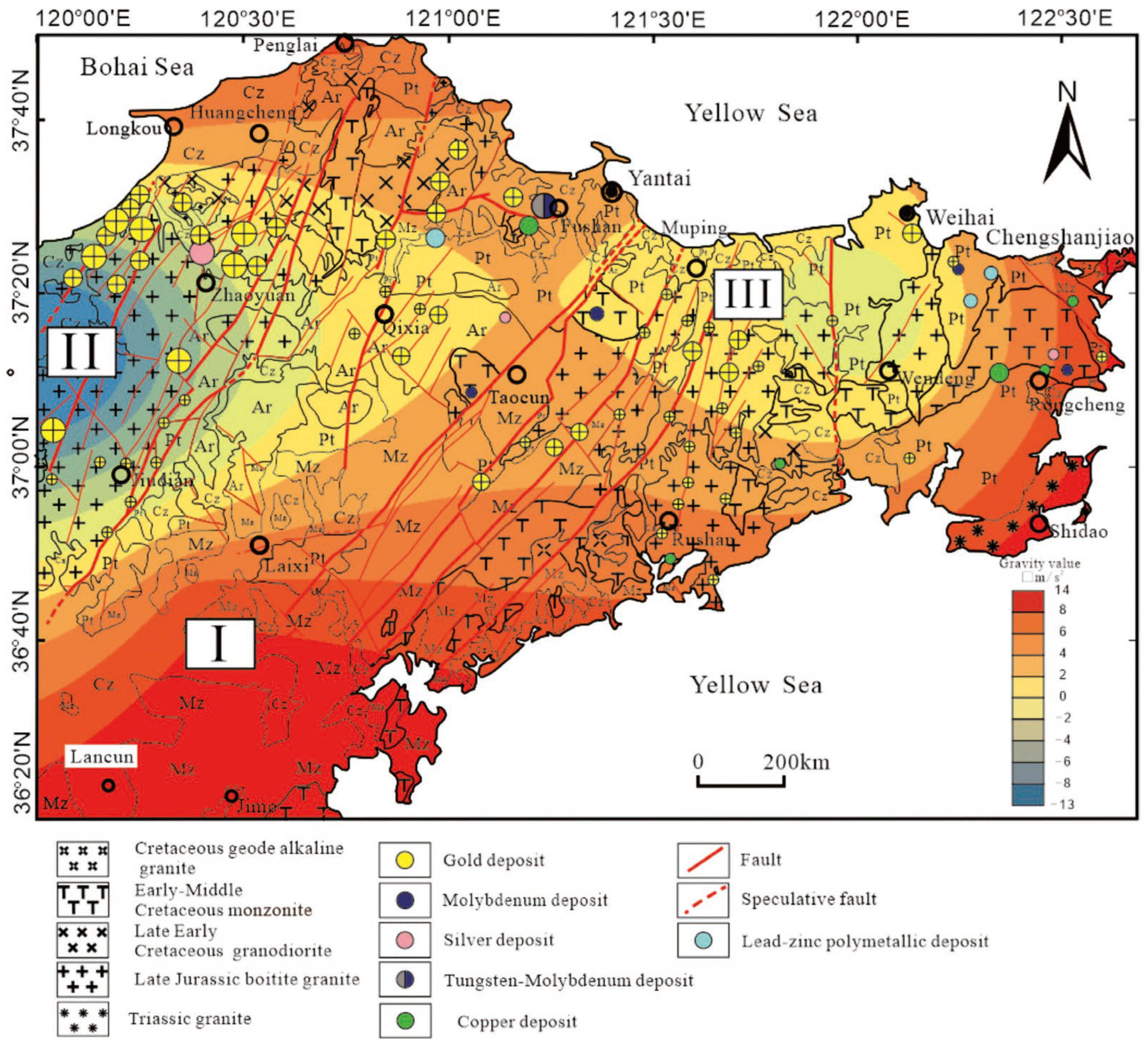


| IO12 | IO13 | IO14 | IO23 | IO24 | IO34 |
|---|---|---|---|---|---|
| 0.033 | 0.093 | 0.065 | 0.033 | 0.032 | 0.084 |
Disclaimer/Publisher’s Note: The statements, opinions and data contained in all publications are solely those of the individual author(s) and contributor(s) and not of MDPI and/or the editor(s). MDPI and/or the editor(s) disclaim responsibility for any injury to people or property resulting from any ideas, methods, instructions or products referred to in the content. |
© 2025 by the authors. Licensee MDPI, Basel, Switzerland. This article is an open access article distributed under the terms and conditions of the Creative Commons Attribution (CC BY) license (https://creativecommons.org/licenses/by/4.0/).
Share and Cite
Fei, J.; Zhu, X.; Chen, Y.; Zheng, A.; Zhao, B.; Zhao, P. Application of BEMD in Extracting Gravity Anomaly Components Showing Deep Ore-Forming Dynamic Background of Jiaodong Gold Cluster Region. Minerals 2025, 15, 1159. https://doi.org/10.3390/min15111159
Fei J, Zhu X, Chen Y, Zheng A, Zhao B, Zhao P. Application of BEMD in Extracting Gravity Anomaly Components Showing Deep Ore-Forming Dynamic Background of Jiaodong Gold Cluster Region. Minerals. 2025; 15(11):1159. https://doi.org/10.3390/min15111159
Chicago/Turabian StyleFei, Jinna, Xu Zhu, Yongqing Chen, Aoyue Zheng, Binbin Zhao, and Pengda Zhao. 2025. "Application of BEMD in Extracting Gravity Anomaly Components Showing Deep Ore-Forming Dynamic Background of Jiaodong Gold Cluster Region" Minerals 15, no. 11: 1159. https://doi.org/10.3390/min15111159
APA StyleFei, J., Zhu, X., Chen, Y., Zheng, A., Zhao, B., & Zhao, P. (2025). Application of BEMD in Extracting Gravity Anomaly Components Showing Deep Ore-Forming Dynamic Background of Jiaodong Gold Cluster Region. Minerals, 15(11), 1159. https://doi.org/10.3390/min15111159







